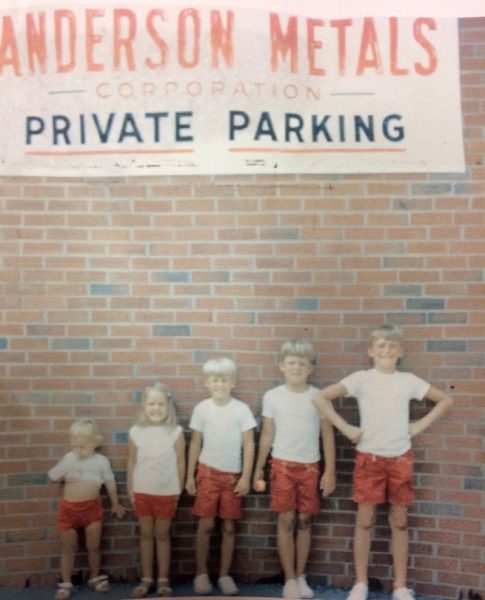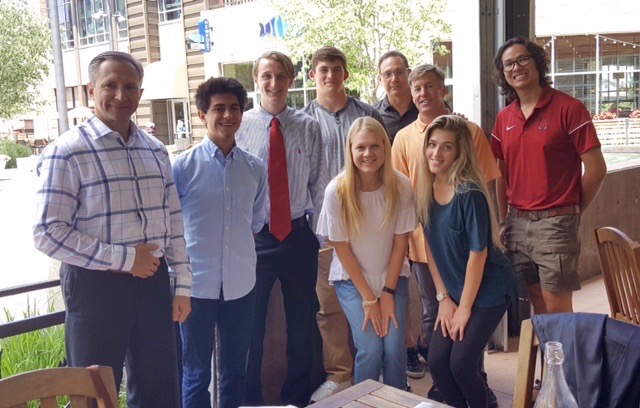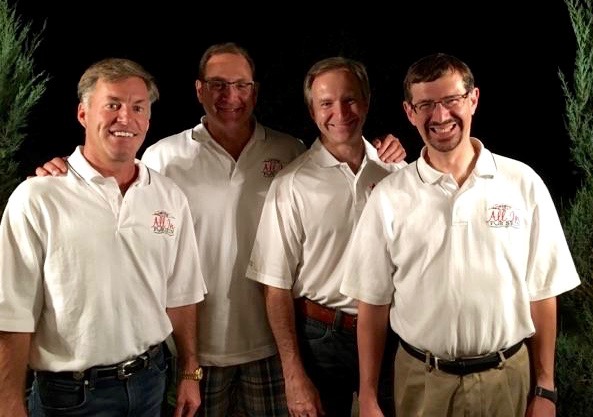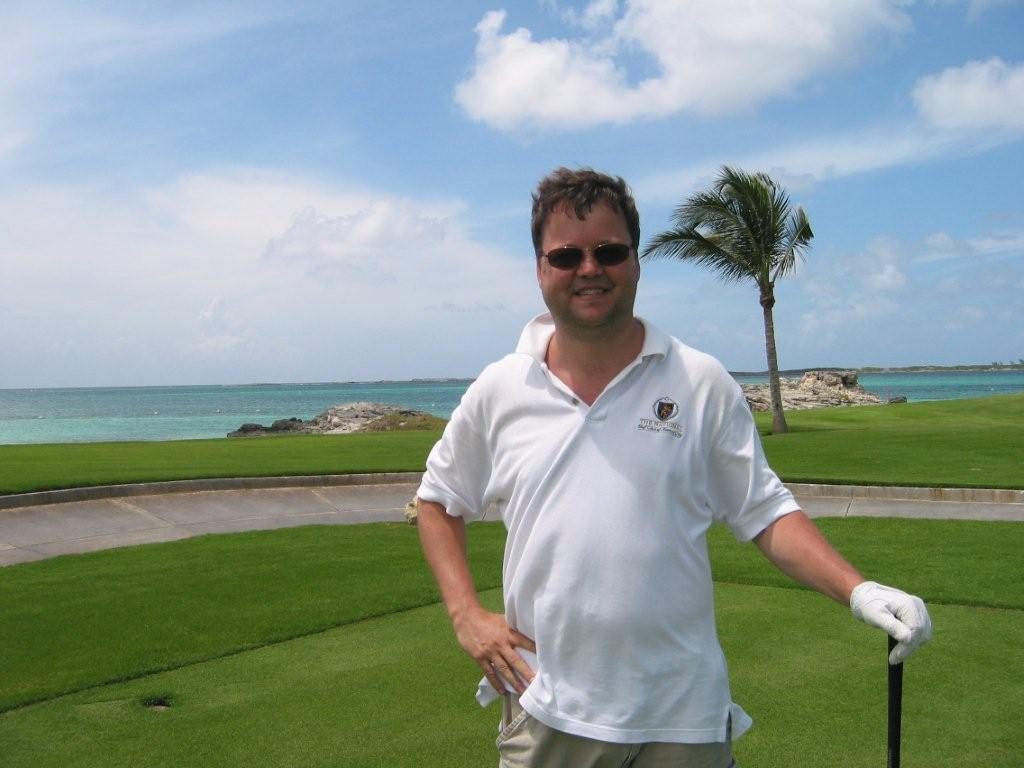Pictured above: Kevin S. Anderson, during a round of golf in Cabo San Lucas, Mexico.
Devastated to lose their brother Kevin to melanoma at age 44, Kevin’s siblings honor his memory by raising money for others affected by skin cancer.
Keith S. Anderson was always close to his older brother, Kevin. Only about a year apart in age, they were numbers two and three of six kids, all with the initials KSA — “so the monogrammed shirts could be easily handed down,” Keith says, laughing. The initials started with their father, Kirk S. Anderson, who ran the family business, Anderson Metals (founded by Kirk’s father, Charles Anderson, in 1947).

The first five of the six Anderson siblings, circa 1972 (left to right): Kregg, Kimberly, Keith, Kevin and Kent.
Growing up in Kansas City, the two boys spent summers swimming in the neighborhood pool, playing kickball, dodgeball or soccer and plotting against their oldest brother, Kent. Even when they had to look after the younger three, Kimberly, Kregg and Kristen, he says, “We were always playing outside.”
And like most people in the 1970s, they didn’t have good sunscreens or even much knowledge about the dangers of the sun. “In those days, people were putting oil on their bodies to try to get a tan,” he says. “Kevin had the fairest skin of all of us. He would get sunburned, and his skin would peel. Kent and I didn’t get sunburned very often — even when I went away to school at Arizona State and would go up onto the roof of the fraternity house to get some rays.”
Kevin was smart, funny and loved to read, Keith says, and he also learned everything he could about computers. He was just 15 hours short of his degree when he decided he’d rather work at Anderson Metals and start making some money. Kent, Keith and Kimberly also went to work for the family business, which manufactures brass fittings, valves and nipples for water, oil and gas. Their four offices were next to each other. They played golf and poker together. Kevin got married to his high-school sweetheart in 1997, and they had two children together.
In the summer of 2006, Kevin noticed a mole on his shoulder that seemed to have changed colors, so he went to see a dermatologist. A biopsy determined that the mole was a malignant melanoma. After Kevin’s surgery to remove the cancer, the doctor said that they had gotten it all, and the chances of it coming back were only 1 or 2 percent.
Still, the doctor stressed how important it was for Kevin to return every six months for a checkup. “Being a numbers guy, though, Kevin figured that a 1 or 2 percent chance of getting it again was so slim that he just decided to forget about it,” Keith says.
About a year and a half later, Kevin started having chest pain. At first he thought it was bronchitis or pneumonia. But his symptoms were caused by something much worse. He learned just a few days before Christmas 2007 that the melanoma had recurred and metastasized throughout his body. “He waited until the day after Christmas to tell me and my brothers and sisters what was going on,” Keith says.
Melanoma specialist Gary Doolittle, MD, professor of clinical oncology at the University of Kansas Medical Center, prescribed the best treatments available at the time, including chemotherapy and interleukin-2, an older form of immunotherapy than what is available today. But Kevin developed life-threatening side effects and couldn’t continue the therapy.
Dr. Doolittle says, “Kevin was a really smart guy. He had done a tremendous amount of research about the disease, was quite knowledgeable and was very interested in clinical trials. He joined a study at another institution and was one of the first people in this country treated with ipilimumab, the first in a new class of drugs that stimulate the body’s immune cells to break out and destroy melanoma.”
Also known as Yervoy, the drug is now extending life for many people with melanoma. Unfortunately, it doesn’t work for everyone, and Kevin’s melanoma progressed. At that point all the doctors could do was try to keep Kevin’s symptoms under control. On December 9, 2008, at the age of 44, Kevin passed away.
A Few Words from Kevin’s Oncologist, Gary Doolittle, MD:
When Kevin Anderson was diagnosed 10 years ago, the only treatment we had for metastatic melanoma that could result in long-term survival was interleukin-2. And it only worked for a small percentage of patients. For most people with widespread disease, we talked about average survival of seven or eight months.
Today there are several FDA-approved immunotherapies, some prescribed in combination, plus targeted agents based on genetic testing, that are changing the landscape of this disease. Not everyone is a candidate for these drugs, and not everyone responds to them. But about one-third of patients are going into remission or stabilizing for a period of years. Just look at former President Jimmy Carter. His experience with these immunotherapies has extended his life dramatically, and has also helped raise awareness about melanoma. It’s so different now than it was for Kevin. People who have melanoma are living longer and better, and while we still have a long way to go, it’s been amazing to watch this unfold.
“That time was very difficult,” Keith recalls. “I don’t think Kevin suffered too much physically, but it was so hard on our family emotionally. Just a week before he died, he seemed completely normal. But in those last few days he went downhill fast, and he passed away the day the hospice care people arrived.”
At the funeral, attended by more than 400 people, Keith says, there were many tears but also a lot of laughter and storytelling — as well as Cokes and M&M’s, which Kevin had loved. “It’s easier to talk about it now without getting too emotional. Time heals all wounds. Let’s face it: We’re all here only temporarily. All we can do is try to make the most of our lives.”
Keith and his oldest brother, Kent, are now co-owners of the family business. “We still have Kevin’s office here vacant for him. We just left it as is,” he says. The family has no history of skin cancer, and no other members of the family have had any signs of it, although they get regular skin checks. They’re also much more vigilant about sun protection.

Six students received $5,000 scholarships from All In For Skin in 2017, presented by Andre Kulikov (far left), Scott Samuels (fifth from left) and Keith Anderson (sixth from left).
To honor Kevin, the family and a group of friends created the nonprofit charity All In For Skin, an annual golf and Texas Hold’em tournament to raise money for college scholarships for kids in Kansas and Missouri whose families have been impacted by melanoma. Keith says, “We’ve had lots of recipients, and at the event some of the kids get up and talk about what’s going on in their lives and how melanoma has changed them. It’s been a great legacy for Kevin.”

All In For Skin’s founders Keith Anderson, president and secretary; Scott Samuels, treasurer; Andre Kulikov, financial advisor; and Ken Sonnenschein, MD, board member.
When board members of All In For Skin were looking for a new program to support, Scott Samuels told them about The Skin Cancer Foundation’s Destination: Healthy Skin program. He loved the idea of a traveling RV that brought screenings and education to thousands of people across the country. The board’s decision to jump-start the 2017 tour with a $100,000 donation was easy. Now they’re not only helping people who have already been affected by melanoma, but also supporting prevention and early detection efforts. Keith says, “We hope this gift will help others avoid what our family went through.”





